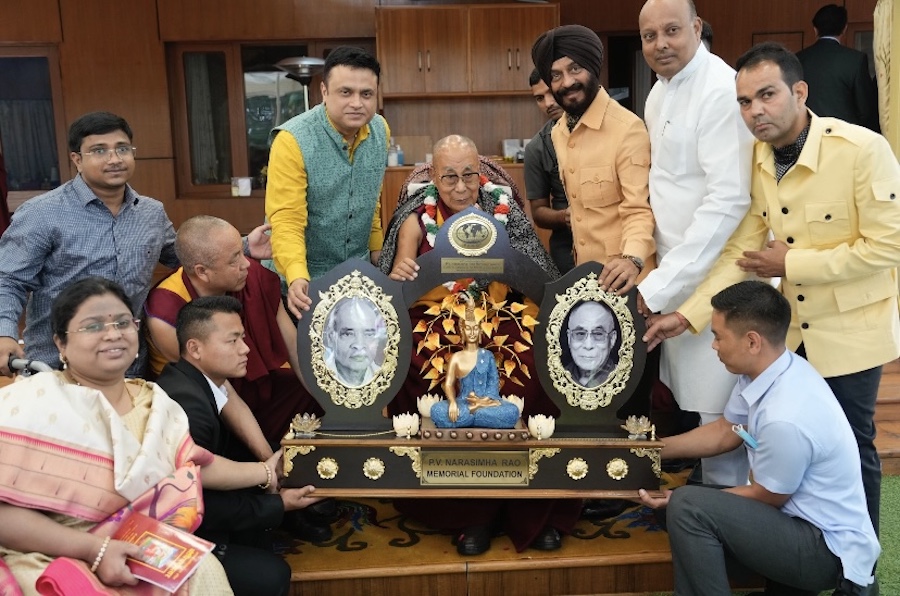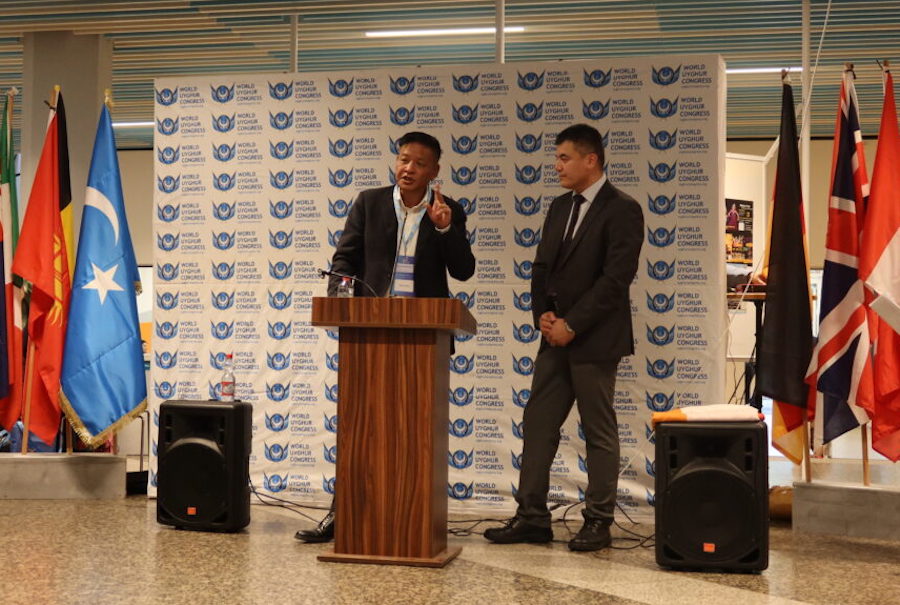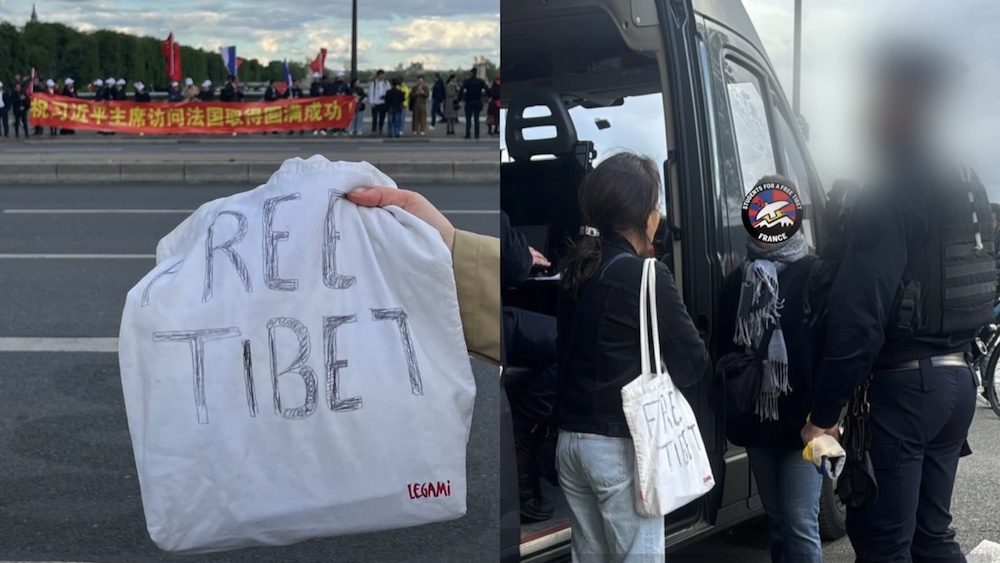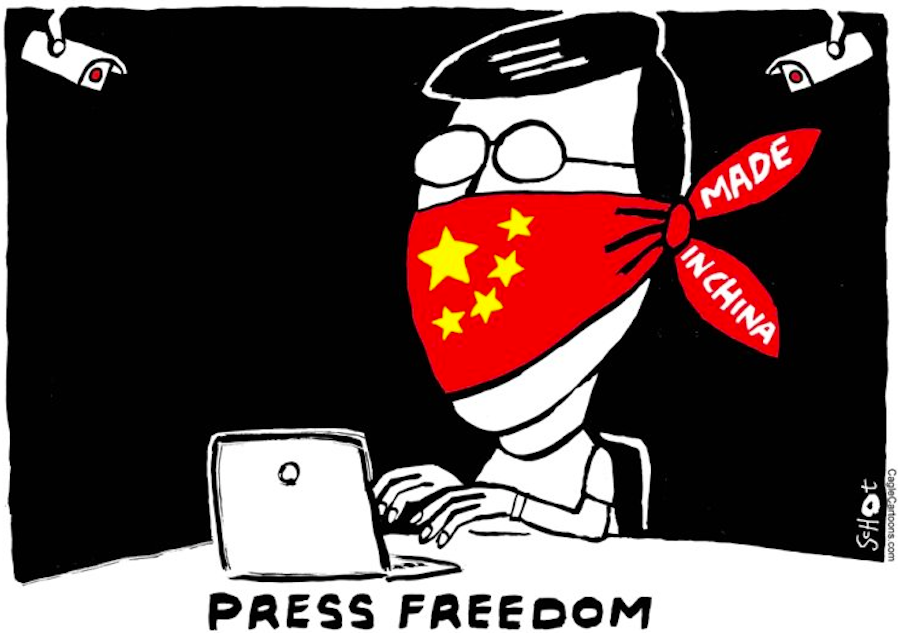PART II
By Julian Gearing
DHARMASALA, India – Karmapa Urgyen Trinley – also sometimes spelt as Orgyen Trinley – has a term for what is holding him back from taking up his seat as head of his Tibetan Buddhist lineage at Rumtek monastery in Sikkim – “environmental problems”. Four years after the Tibetan lama hit the world headlines when he left his monastery in Tibet aiming for his “crown”, he has hit a brick wall.
In his private audience room in Gyuto monastery, a short distance from the Dalai Lama in Dharamsala, the young lama prefers not to talk about the politics that prevent him from going to the Karma Kagyu school’s exile headquarters Rumtek, saying that the process of resolving the problem “takes time”. As he speaks, Indian intelligence agents, standing a discrete distance away, try to listen in on the conversation. Soldiers carrying assault rifles stand guard outside.
Indian authorities are suspicious over why the first high lama to be recognized by the Chinese communist government should want to flee Tibet. Since his journey into exile, the lama has only been given permission by the Indian authorities to travel on pilgrimages to holy places. And he is banned from travelling to his goal, Rumtek, in Sikkim, a small Himalayan state under Indian administration but claimed by China.
Urgyen Trinley’s problems have just ratcheted up a notch. A bitter legal contest over the assets of Rumtek monastery has resulted in an unfavorable verdict. An Indian court in Sikkim ruled on September 28 that the assets of Rumtek belong to the Karmapa Charitable Trust, set up by the late 16th Karmapa, or head of monastery. The trustees support another claimant to the Karmapa throne, Karmapa Thaye Dorje, whom they say has the right to take over the monastery. Urgyen Trinley’s followers, whose monks currently occupy the premises, made an appeal on December 4 to the Supreme Court.
If one legal tussle was not enough, another has just commenced. On December 19, the Delhi High Court issued a summons to the Dalai Lama and the Indian government claiming as illegal the declaration of Urgyen Trinley as the 17th Karmapa and calling for his expulsion from India. The case, filed by Lama S N Singh, alleges that the Dalai Lama was wrong in backing the recognition of Urgyen Trinley as the 17th Karmapa, and claims that his birth date in 1985 is wrong, saying that medical records indicate that he is much older. In addition, it claims the Chinese game plan is to annex Buddhist regions of the Himalaya, and that the easiest way for the Chinese to establish a base in Sikkim is to install their own Karmapa candidate, and China’s man is Urgyen Trinley. Although this case may prove to be more of a nuisance than a real threat, it is another burden for the young lama.
In the tale of two boys competing for the Karmapa throne, the stakes are high. The future of the Karma Kagyu Tibetan Buddhist lineage is on the line. The competition revolves around who will put on the famous Black Hat and take over from the 16th Karmapa Rangjung Rigpai Dorje, who died in 1981. This charismatic lama fled Chinese oppression in Tibet in 1959 and set up Rumtek in Sikkim as his exile seat. Tibetan Buddhists believe in reincarnation and that some high lamas, or tulku as they are called, come back life after life to help others to pursue enlightenment.
It is not unusual to have two competing candidates for the position of tulku. Over the centuries since the 3rd Karmapa started the practice of recognition – subsequently taken up by the Dalai Lamas – competition, intrigue and murder have on occasions beset the different Buddhist lineages. What is unusual to have two boys separately recognized and brought up to continue a lineage – and for this to be played out in the modern world where competing Karmapa Internet websites struggle to put forward their case.
But more is at stake than just one Buddhist lineage. The conflict between supporters of the two claimants to the Karmapa throne has not only thrown the Karma Kagyu lineage, one of the four main Tibetan Buddhist schools, into confusion and set off violence. Critics say the “Karmapa controversy” is a threat to Tibetan Buddhism and the practice of recognizing the reincarnations of high masters. And it has allowed the atheist Chinese authorities to put their foot in the door. Some critics who say that Urgyen Trinley has Chinese backing content that his flight from Tibet was made to look like an escape. They claim that he aimed to go to Sikkim to stake a “Chinese” foothold there, or to go and claim the Black Hat and then return to Tibet.
Sitting in Gyuto monastery, Urgyen Trinley says that he prefers not to talk about the fact that there are two Karmapas. “Generally speaking, I follow the Dalai Lama’s advice. The Dalai Lama is very kindly helping the Karmapa cause,” he said, referring to how the Tibetan leader has officially backed him as the reincarnation of the 16th Karmapa. As Lama Phuntsok, an aide to the young lama, states: “If you are a Dalai Lama follower, then you have no doubt.”
That is generally true. In Dharamsala, the headquarters of the Dalai Lama’s Tibetan exile government, photos of the Dalai Lama holding hands with Urgyen Trinley abound, as do stickers, books and CDs devoted to the young lama. The media’s portrayal of the young lama’s heroic escape from Tibet over the Himalayan passes into Nepal and India was a useful propaganda coup for the exile government. One international publication nominated Urgyen Trinley as an “Asian Hero” for his escape. Some publications even went as far as suggesting that he could take over as the Tibetans’ spiritual leader after the Dalai Lama passes away, an idea the Tibetan leader was quick to quash.
The Dalai Lama has thrown his weight behind Urgyen Trinley, but behind the scenes the story of how the lama was recognized is murky. After the 16th Karmapa died of cancer in 1981, the four regents in charge of looking for his reincarnation had trouble finding the boy who would take over. While the Tibetan Buddhist lineages use various methods for finding the reincarnation of a high lama, the Karmapa traditionally wrote a letter before he died indicating where his successor would be found. Eventually in 1992 one of the regents, Tai Situ Rinpoche, produced a letter which he said had been hidden in a talisman given to him by the 16th Karmapa. But when regent Shamar Rinpoche saw it he claimed it was forged, alleging the script was “100 percent Tai Situ’s handwriting”.
Shamar, though, was in a minority. His call for a forensic test of the letter was overridden and the search went ahead. Tai Situ brought in the Dalai Lama to officially bless the recognition, which critics say is an unusual step as the Dalai Lama is head of the Gelukpa Buddhist lineage, not the Karma Kagyu. What also raised eyebrows was the involvement of the communist Chinese authorities. In 1992, Urgyen Trinley was installed in the traditional Karmapa seat in Tibet, Tsurphu monastery, near Lhasa, and officially declared a “Living Buddha” by the communist authorities. Critics say that this was to set a bad precedent, leading to the Chinese authorities appointing their own Panchen Lama, second in line to the Tibetan leader, and a declaration that they will choose the next Dalai Lama.
Tai Situ is adamant that the letter was not forged and that his methods are beyond reproach. “There is not such a thing as proving [his recognition],” he said, shortly after Urgyen Trinley arrived in India. “The Karmapa is the Karmapa. Buddha is Buddha. Dalai Lama is Dalai Lama. Christ is Christ. We are believers.” Thrangu Rinpoche, one of the main players involved in the recognition, also backs Tai Situ’s position. Speaking in his monastery in Kathmandu recently he said: “The Dalai Lama examined the recognition letter. He also had a dream that confirmed the reincarnation.”
As for the question over the wisdom of bringing in the Chinese authorities, Tai Situ’s aide Akong Rinpoche, based in Kagyu Samye Ling monastery in Scotland, said cooperating with the Chinese was necessary, claiming that there was a need to “legalize” the Karmapa’s position in Tibet. Akong, who played a major role in finding Urgyen Trinley in eastern Tibet, rebuffs critics who say the young lama should have been smuggled out of Tibet in order to be free to fully practice his religion.
Whether the recognition of Urgyen Trinley was a joyous event, as his supporters claim, or a “spiritual coup” carried out by Tai Situ and the Dalai Lama, as critics claim, the recognition has to be understood against the backdrop of old world Tibetan politics. Tibetan society is autocratic and hierarchical, especially in the Buddhist orders. Since the Dalai Lama fled Tibet after the Lhasa Uprising in 1959, he had been trying without success to bring unity to the Buddhist schools, bringing together his Gelukpa lineage with the Nyingma, Sakya, Karma Kagyu and other smaller schools, including the animist Bon religion.
The 16th Karmapa had been stubborn in his insistence on maintaining the independence of his school, and maintained a “loyal opposition” to the Dalai Lama’s government. After the murder in the 1970s of one of the Karmapa’s supporters who was the head a group of refugee settlements, the Karmapa took more care with his security and spent more time overseas. He died in the United States in 1981. The Tibetan leader’s efforts to bring him into the fold failed. Then in 2000, Urgyen Trinley arrived on his doorstep.
Today the Dalai Lama’s drive to forge unity is bearing fruit, with the 17th Karmapa under his care. What is not needed, as far as the Tibetan leader and the exile government is concerned, is a challenge by another claimant to the Karmapa throne. That challenge comes from a quietly spoken young man who resides in Kalimpong, near Sikkim, a long distance from Dharamsala. Like Urgyen Trinley, Thaye Dorje says that he prefers to stay away from politics. But while Urgyen Trinley talks earnestly of going to Rumtek, Thaye Dorje is more reticent. “Speaking frankly, the monastery is just bricks and mortar. That’s it. But the thing there has a meaning behind it. The previous Karmapa built it to spread the Dharma all over the world. Probably one can do that again.”
Thaye Dorje, 19, is mindful of the need for a monastery. He lives in a house in Kalimpong and his monks, thrown out of Rumtek by Urgyen Trinley’s followers, live in largely squalid conditions down the hill from Rumtek. The young lama says that he is focused on the role he has to play. “Through learning and teaching Dharma, I will be able to help people, and help myself, it is a great joy. Of course, it is not easy. There are ups and downs, especially when you have such a name and a responsibility. You are under pressure. But it is worth that pressure.”
Shamar recaps the story of how he recognized Thaye Dorje as the Karmapa. He says that he had already announced that the Karmapa had been reborn in Tibet before what he calls “the trouble” happened in 1992. “My search started in 1990. I publicly announced it then,” he said, claiming he was in a position to make the search. “In history, a number of Karmapas did not leave a letter. When they did not leave a letter, then the Shamarpa [his other title] always recognized.” After Thaye Dorje was “found” in Tibet, he was quietly smuggled out with his family in 1994.
Critics, though, question why Shamar opposed the recognition of Urgyen Trinley and then told the Dalai Lama that he accepted it. Lama Phuntsok at Gyuto Monastery said: “He has changed his mind three times over the recognition of the Karmapa. Maybe it is not him, maybe it is his advisors, Tibetan businessmen.”
Despite the grumbles from both sides, both boys have many supporters and both are poised to come into their own. Within a couple of years they will reach the stage where they are knowledgeable enough to teach, though they currently officiate at ceremonies. But whether either one of them will be allowed to go to Rumtek, the Karmapa exile seat, will depend on the Indian authorities and the outcome of court cases. Although the legal system works slowly in India, the Supreme Court’s ruling on the assets of Rumtek may not be long in coming.
For Urgyen Trinley, the “environmental problems” of court rooms, law suits and Indian security are proving a hindrance he could do without. For the young man recognized by the Dalai Lama as the 17th Karmapa, the long journey from Tibet to Rumtek is proving arduous. Not that he needs to enter the monastery to confirm his status. “Historically, once there has been recognition, whatever the age of the child, it is full recognition,” he said. “It is not dependent on one day putting on the Black Hat of the Karmapas.”
Publicly, Urgyen Trinley is the height of cool. “As His Holiness the Dalai Lama says, avoid attachment,” he said. “Because of this, I don’t get attached to where I am staying.”
That may be so, but the Black Hat remains under lock and key in Rumtek monastery.









